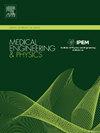Predicting ground reaction forces and center of pressures from kinematic data in crutch gait based on LSTM
IF 2.3
4区 医学
Q3 ENGINEERING, BIOMEDICAL
引用次数: 0
Abstract
Crutches are of extensive applications in the field of rehabilitation. Comprehensively analyzing the ground reaction forces (GRFs) on both crutches and feet can evaluate the patients’ walking function recovery. Given more force platforms are needed in clinical evaluation for the crutch gait than the normal gait pattern and the resulting high cost, this research proposes a method to predict both ground and foot GRFs during walking with crutches, using kinematic information from motion capture trials. We collected force and motion data, built a musculoskeletal model in Opensim, and computed joint angles and moments of crutch gait. Different Artificial Neural Networks (ANN), including Multilayer Perceptron (MLP), Convolutional Neural Network (CNN), and Long Short-Term Memory network (LSTM) were established to test their predictive ability using Leave-One-Subject-Out(LOSO) cross validation method. LSTM model showed the strongest agreement, with r = 0.961±0.050 and nRMSE=13.8 % in the vertical direction of the left foot. The LSTM model was more accurate than the CNN model and more robust than the MLP model in this component. In average of different directions, LSTM model has r = 0.656±0.362 and nRMSE=30.3 %. Further verification of the prediction was executed by computing joint moments. The LSTM model showed great application prospects in crutch gait GRF analysis.
基于LSTM的拐杖步态运动学数据预测地面反作用力和压力中心
拐杖在康复领域应用广泛。全面分析拐杖和双脚的地面反作用力(GRF)可以评估患者的行走功能恢复情况。与正常步态相比,拐杖步态的临床评估需要更多的力平台,且成本较高,因此本研究提出了一种利用运动捕捉试验的运动学信息来预测拐杖行走时地面和足部 GRF 的方法。我们收集了力和运动数据,在 Opensim 中建立了肌肉骨骼模型,并计算了拐杖步态的关节角度和力矩。我们建立了不同的人工神经网络(ANN),包括多层感知器网络(MLP)、卷积神经网络(CNN)和长短期记忆网络(LSTM),并使用 "留空受试者 "交叉验证法测试了它们的预测能力。LSTM 模型显示出最强的一致性,在左脚垂直方向上的 r = 0.961±0.050,nRMSE=13.8 %。在这一部分,LSTM 模型比 CNN 模型更准确,比 MLP 模型更稳健。在不同方向的平均值上,LSTM 模型的 r = 0.656±0.362,nRMSE=30.3 %。通过计算联合矩进一步验证了预测结果。LSTM 模型在拐杖步态 GRF 分析中展现了巨大的应用前景。
本文章由计算机程序翻译,如有差异,请以英文原文为准。
求助全文
约1分钟内获得全文
求助全文
来源期刊

Medical Engineering & Physics
工程技术-工程:生物医学
CiteScore
4.30
自引率
4.50%
发文量
172
审稿时长
3.0 months
期刊介绍:
Medical Engineering & Physics provides a forum for the publication of the latest developments in biomedical engineering, and reflects the essential multidisciplinary nature of the subject. The journal publishes in-depth critical reviews, scientific papers and technical notes. Our focus encompasses the application of the basic principles of physics and engineering to the development of medical devices and technology, with the ultimate aim of producing improvements in the quality of health care.Topics covered include biomechanics, biomaterials, mechanobiology, rehabilitation engineering, biomedical signal processing and medical device development. Medical Engineering & Physics aims to keep both engineers and clinicians abreast of the latest applications of technology to health care.
 求助内容:
求助内容: 应助结果提醒方式:
应助结果提醒方式:


